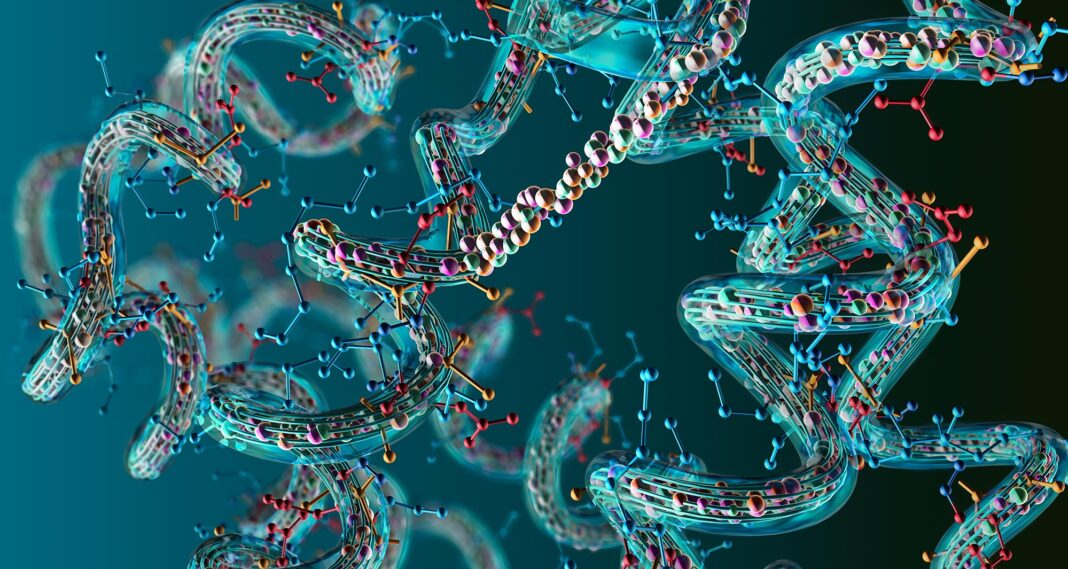At the University of Oxford, scientists have developed a nanopore technology that can identify three different post-translational modifications (PTMs) in individual proteins, even deep within long protein chains. The scientists asserted that their technology “[lays] the groundwork for compiling inventories of the proteoforms in cells and tissues.”
The technology was introduced in Nature Nanotechnology, in a paper titled, “Enzyme-less nanopore detection of post-translational modifications within long polypeptides.” The paper noted that single-molecule proteoform identification requires knowledge of the architecture of long polypeptide chains, knowledge that has proven elusive. Although there are methods for translocating folded proteins through solid-state nanopores or protein nanopores of large sizes, these methods have yet to locate PTMs within a polypeptide sequence. The methods that have detected PTMs have been able to do so only within short peptides.
In their paper, the Oxford scientists described their approach: ”We use electro-osmosis in an engineered charge-selective nanopore for the non-enzymatic capture, unfolding, and translocation of individual polypeptides of more than 1,200 residues. Unlabeled thioredoxin polyproteins undergo transport through the nanopore, with directional co-translocational unfolding occurring unit by unit from either the C or N terminus. Chaotropic reagents at non-denaturing concentrations accelerate the analysis.”
The scientists elaborated on nanopore DNA/RNA sequencing technology. Specifically, the scientists used a directional flow of water to capture and unfold 3D proteins into linear chains and feed them through pores that were just wide enough to allow the passage of a single amino acid. Structural variations were identified by measuring changes in an electrical current applied across the nanopore. Different molecules caused different disruptions in the current, giving them a unique signature.
The team successfully demonstrated the method’s effectiveness in detecting three different PTM modifications (phosphorylation, glutathionylation, and glycosylation). These included modifications deep within the protein’s sequence. Importantly, the method does not require the use of labels, enzymes, or additional reagents.

According to the research team, the new protein characterization method could be readily integrated into existing portable nanopore sequencing devices to enable researchers to rapidly build protein inventories of single cells and tissues. This could facilitate point-of-care diagnostics, enabling the personalized detection of specific protein variants associated with diseases including cancer and neurodegenerative disorders.
“This simple yet powerful method opens up numerous possibilities,” said Yujia Qing, PhD, an associate professor of organic chemistry at the University of Oxford and a corresponding author for the current study. “Initially, it allows for the examination of individual proteins, such as those involved in specific diseases. In the longer term, the method holds the potential to create extended inventories of protein variants within cells, unlocking deeper insights into cellular processes and disease mechanisms.”
The current study’s other corresponding author was Hagan Bayley, PhD, a professor of chemical biology at the University of Oxford and a co-founder of Oxford Nanopore Technologies. He pointed out that the ability to pinpoint and identify post-translational modifications and other protein variations at the single-molecule level “holds immense promise for advancing our understanding of cellular functions and molecular interactions.” He added that it may “open new avenues for personalized medicine, diagnostics, and therapeutic interventions.”
The study’s authors emphasized that technologies to analyze cellular proteins and their millions of variants at the single-molecule level would uncover substantial information previously unknown to biology.
Although human cells contain approximately 20,000 protein-encoding genes, the actual number of proteins observed in cells is far greater, with over 1,000,000 different structures known. These variants are generated through PTMs, which are structural changes that occur to proteins after they have been transcribed from DNA. These changes—such as the addition of chemical groups or carbohydrate chains to the individual amino acids that make up a protein—result in hundreds of possible variations for the same protein chain.
These variants play pivotal roles in biology, by enabling precise regulation of complex biological processes within individual cells. The mapping of PTMs would uncover a wealth of valuable information that could revolutionize our understanding of cellular functions.



